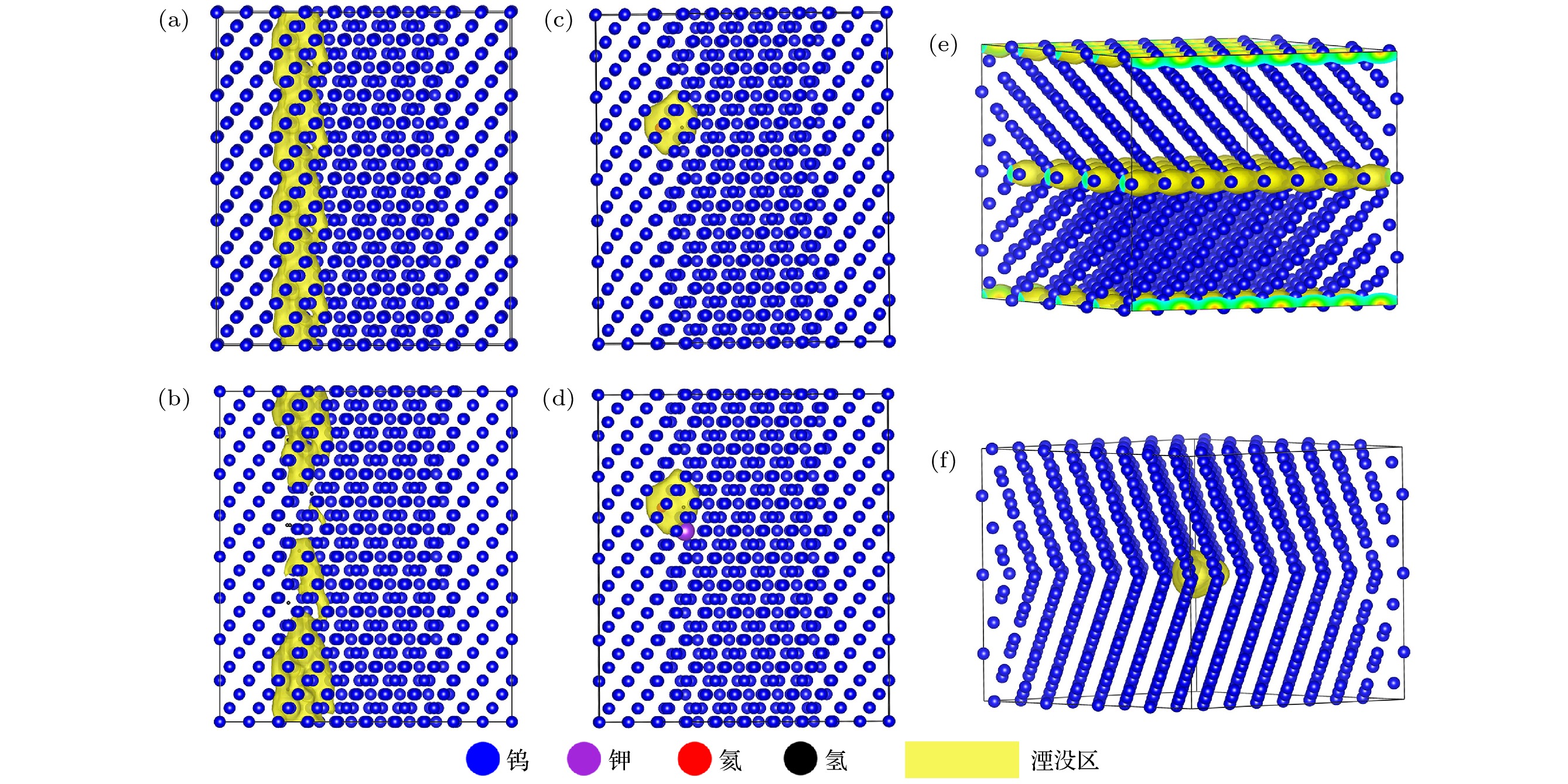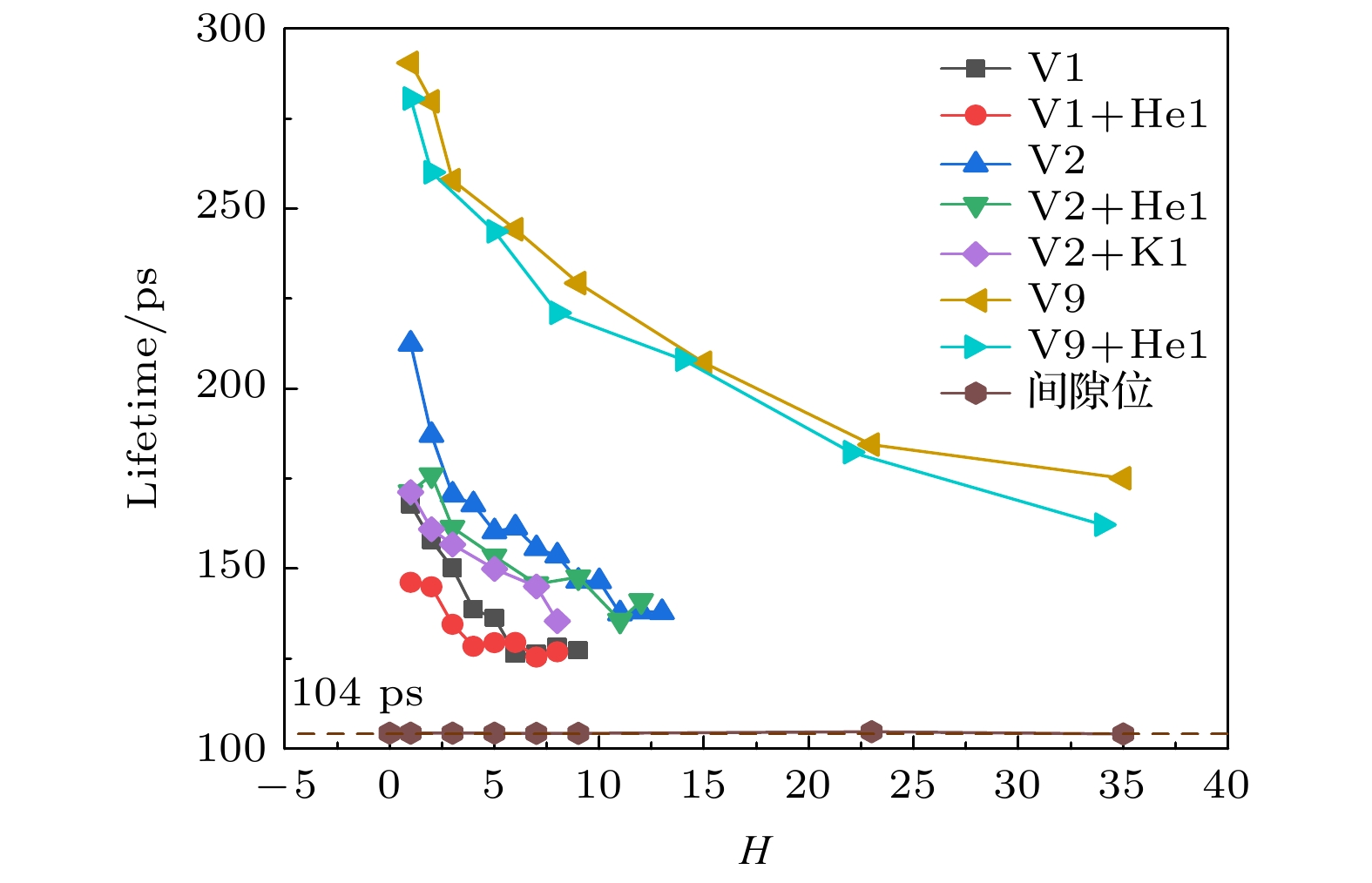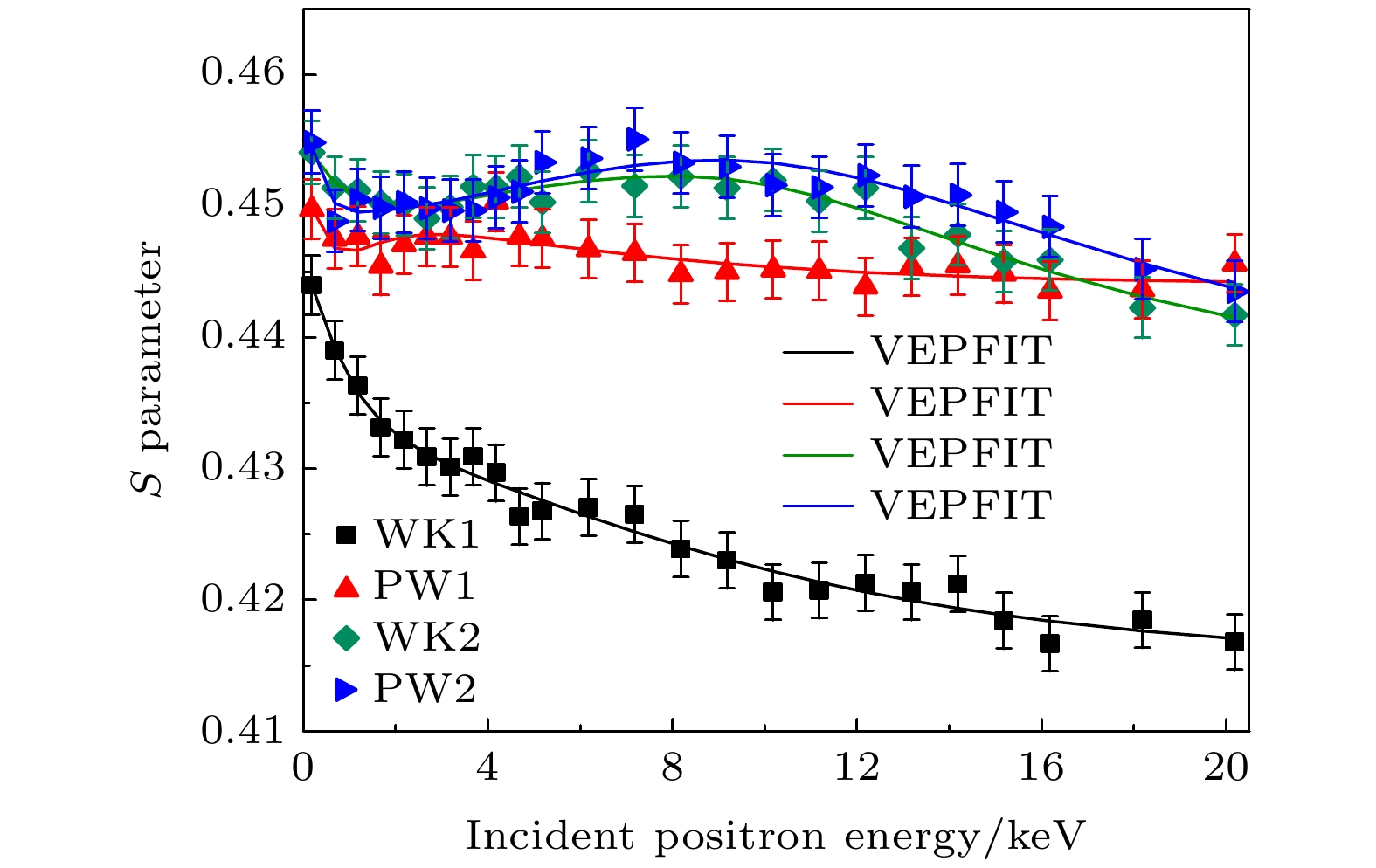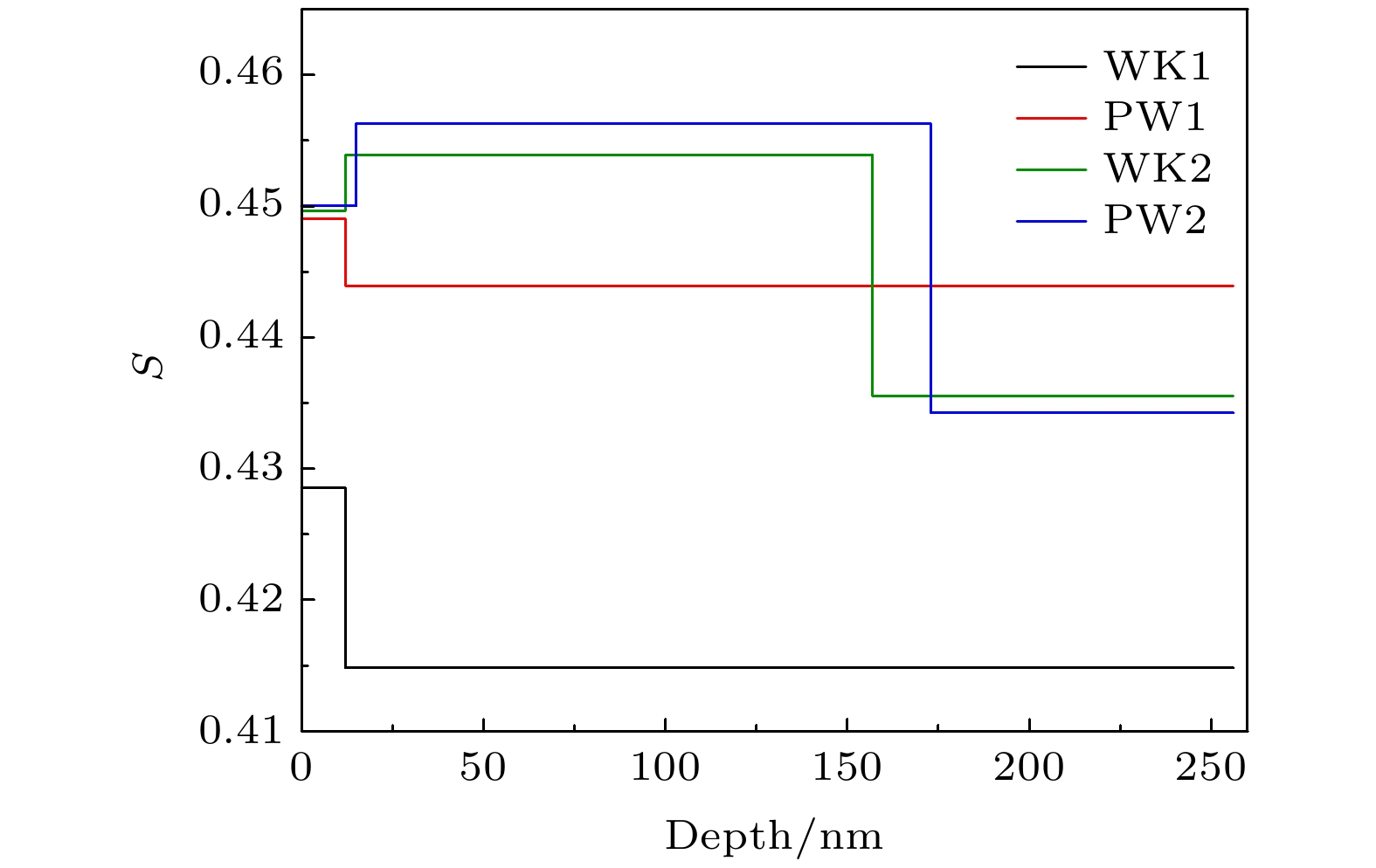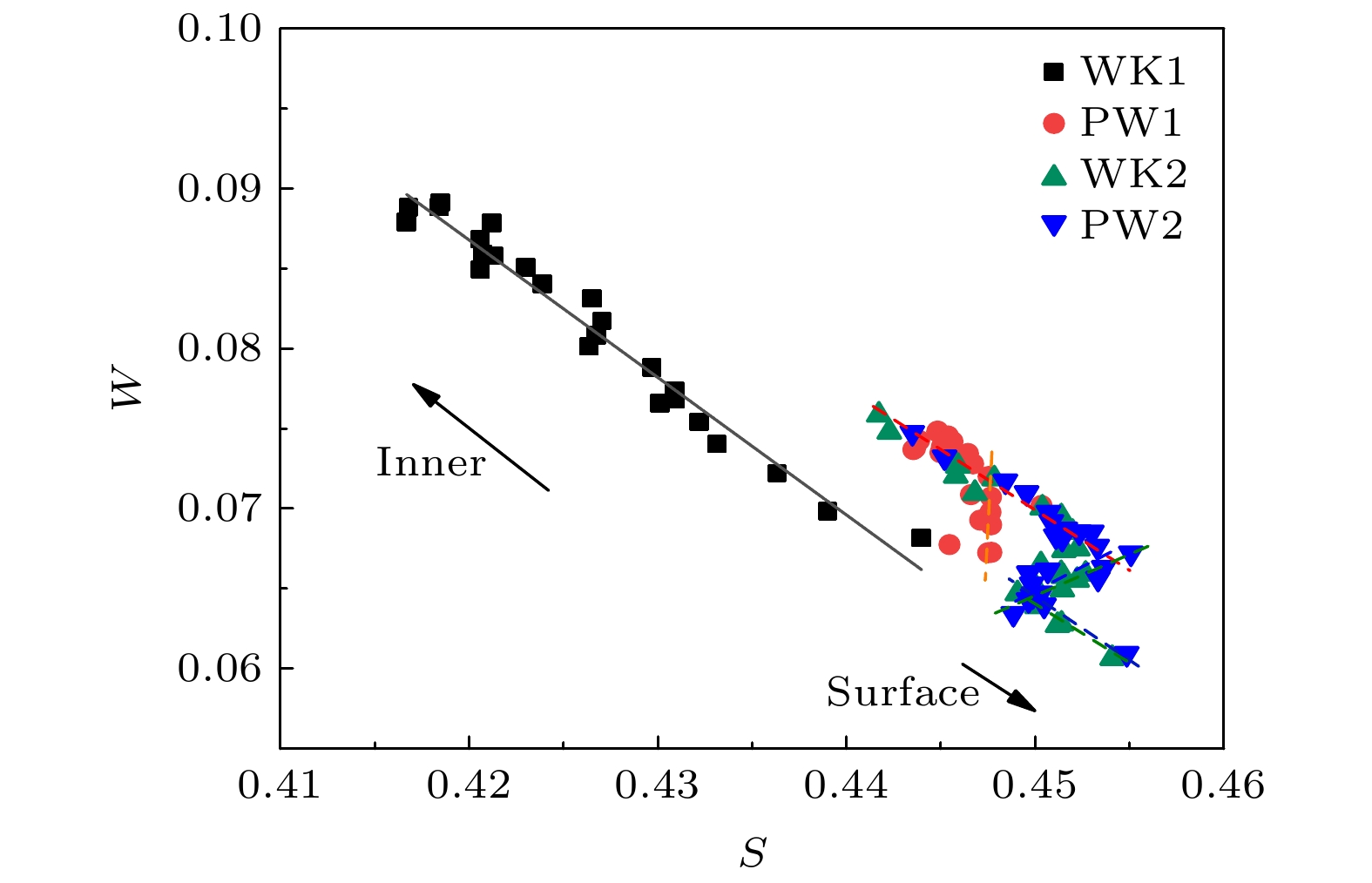-
钾掺杂钨合金是一种典型的弥散强化钨基材料, 钾掺入在提高钨材料抗冲击能力的同时, 也引入大量缺陷, 这些缺陷会对合金在服役过程中氢原子和氦原子的存在形态以及演变产生影响. 本文使用正电子湮没谱学方法从微观角度研究辐照后钨钾合金中的缺陷信息, 通过对氢氦相关缺陷的正电子湮没参数进行模拟, 发现氢原子对正电子寿命的影响比氦原子小, 弥散在位错或晶界中的氢、氦原子会影响正电子湮没区域, 而单个钾原子的存在对氢氦相关缺陷的正电子寿命影响甚微; 结合扫描电镜与正电子湮没寿命谱和慢正电子束多普勒展宽谱, 测试结果确认了钨钾合金中钾泡以及其钉扎的位错等缺陷对氢原子和氦原子的影响, 与纯钨相比, 在纯H和H+6%He中性束辐照下钾泡等缺陷会促进氢原子的释放, 同时成为氦原子的捕获中心, 促使其形成氦-空位复合体, 并在此成核, 生长为尺寸更大的氦泡, 在应力和温度梯度的作用下促进其从表面释放, 有利于相关缺陷的恢复, 降低其损伤程度.Pure tungsten (W) is a primary plasm-facing material (PFM) candidate because of its superior properties, but it still has some drawbacks. In order to solve these problems, various methods have been used to improve the performances of tungsten-based materials. Potassium (K) doping, as one of the typical dispersion-strengthening methods for W materials, improves low temperature brittleness, reduces the ductile-brittle transition temperature, and suppresses the recrystallization. Meanwhile, it also improves the thermal shock resistance and fracture toughness of the material by introducing nano-sized K bubbles. However, this method brings a large number of defects inevitably. In fact, the K bubbles and the dislocations which are pinned by these K bubbles can affect the morphology and evolution of hydrogen (H) and helium (He) atoms in the alloys. As a very sensitive method to detect vacancy-type defects in materials, positron annihilation spectroscopy is used to study the irradiation damage caused by H and He atoms in this paper. The calculation of positron lifetime shows that positrons are more sensitive to the vacancy-type defects. Bounding of H and He with vacancies reduces the positron lifetime because of the increase of valence electron density. Combining the calculated results with the positron annihilation lifetime spectrum (PLAS) results shows that the W-K alloy is easier to promote the H atoms to release. Besides, it also more likely to form larger He bubbles which can be estimated by positron lifetime values. The result is also confirmed by the measurements from the scanning electron microscope (SEM) and slow positron Doppler broadening spectroscopy (DBS). The defects in the W-K alloy such as K bubbles and their pinned dislocations can act as diffusion channels to promote the H atoms to release, which gives rise to a smoother surface under the pure H irradiation. Meanwhile, under the condition of the H+6%He irradiation, the K bubbles and their pinned dislocations in the W-K alloy become the capture center of He atoms, promote their nucleation and grow into larger He bubbles. Moreover, under the action of stress and temperature gradient, some of the He bubbles migrate to the surface and release, this process is conducive to the recovery of related defects and the reduction of radiation damage.
-
Keywords:
- positron annihilation spectroscopy /
- neutral beam irradiation /
- potassium-tungsten alloy /
- potassium doping
[1] Ueda Y, Coenen J W, Temmerman G D, Doerner R P, Tsitrone E 2014 Fusion Eng. Des. 89 901
 Google Scholar
Google Scholar
[2] Gumbsch P, Riedle J, Hartmaier A, Fischmeister H F. 1998 Science. 282 1293
 Google Scholar
Google Scholar
[3] Gumbsch P 2003 J. Nucl. Mater. 323 304
 Google Scholar
Google Scholar
[4] Giannattasio A, Yao Z, Tarleton E, Roberts S G 2010 Philos Mag. 90 3947
 Google Scholar
Google Scholar
[5] Rupp D, Weygand S M 2010 Philos Mag. 90 4055
 Google Scholar
Google Scholar
[6] Bonnekoh C, Lied P, Pantleon W, Karcher T, Leiste H, Hoffmann A, Reiser J, Roeth M 2020 Int. J. Refract. Met. Hard Mater. 93 105347
 Google Scholar
Google Scholar
[7] Zhang X X, Yan Q Z, Yang C T, Wang T N, Xia M, Ge C C 2016 Rare Metals. 35 566
 Google Scholar
Google Scholar
[8] Levin Z S, Brady B G, Foley D C, Hartwing K T 2019 Int. J. Refract. Met. Hard Mater. 83 104966
 Google Scholar
Google Scholar
[9] Fan J L, Liu T, Cheng H C, Wang D L 2008 J. Mater. Process. Techol. 208 463
 Google Scholar
Google Scholar
[10] Shen Y, Xu Z, Cui K, Yu J 2014 J. Nucl. Mater. 455 234
 Google Scholar
Google Scholar
[11] Zhang X, Yan Q, Lang S, Xia M, Liu X, Ge C 2014 J. Nucl. Mater. 455 537
 Google Scholar
Google Scholar
[12] Guan W, Nogami S, Fukuda M, Hasegawa A 2016 Fusion Eng. Des. 109-111 1538
[13] Schade P 2013 Int. J. Refract. Met. Hard Mater. 28 648
[14] Nogami S, Watanabe S, Reiser J, Rieth M, Sickinger S, Hasegawa A 2019 Fusion Eng. Des. 140 48
 Google Scholar
Google Scholar
[15] Huang B, Chen L Q, Qiu W B, Yang X L, Shi K, Lian Y Y, Liu X, Tang J 2019 J. Nucl. Mater. 520 1
 Google Scholar
Google Scholar
[16] Feng F, Lian Y, Wang J, Chen Z, Huang B 2019 Tungsten. 1 1
 Google Scholar
Google Scholar
[17] Zibrov M, Egger W, Heikinheimo J, Mayer M, Toumisto F 2020 J. Nucl. Mater. 531 152017
 Google Scholar
Google Scholar
[18] Ramachandran R, David C, Magudapathy P, Rajaraman R, Govindaraj R, Amarendra G 2019 Fusion Eng. Des. 142 55
[19] Greuner H, Boeswirth B, Boscary J, Mcneely P 2007 J. Nucl. Mater. 367-370B 1444
[20] Feng F, Liu X, Lian Y, Greuner H, Böswirth B, Wang J B, Chen Z 2019 J. Nucl. Mater. 516 178
 Google Scholar
Google Scholar
[21] 王少阶, 陈志权, 王波, 吴奕初, 方鹏飞, 张永学 著 2008 应用正电子谱学 (武汉: 湖北科学技术出版社) 第57页
Wang S J, Chen Z Q, Wang B, Wu Y C, Fang P F, Zhang Y X 2008 Applied Positron Spectroscopy (Wuhan: Hubei Science and Technology Press) p57 (in Chinese)
[22] Puska M J, Nieminen R M 1983 J. Phys. F:Met. Phys. 13 333
 Google Scholar
Google Scholar
[23] Campillo Robles J M, Ogando E, Plazaola F 2007 J. Phys. Condens. Matter 19 176222
 Google Scholar
Google Scholar
[24] Arponen J, Pajanne E 1978 Ann Phys. 121 343
[25] Boroński E, Nieminen R M 1986 Phys.l Rev. B. 34 3820
 Google Scholar
Google Scholar
[26] Lantto, Lauri J 1987 Phys. Rev. B. 36 5160
 Google Scholar
Google Scholar
[27] Kimball G E, Shortley G H 1934 Phys. Rev. 45 343
 Google Scholar
Google Scholar
[28] Clark S J, Segall M D, Pickard C J, Hasnip P J, Probert M I J, Refson K, Payne M C 2005 Zeitschrift Für Krist. 220 567
[29] Vanderbilt D 1990 Phys. Rev. B 41 7892
 Google Scholar
Google Scholar
[30] Perdew J P, Chevary J A, Vosko S H, Jackson K A, Pederson M R, Singh D J, Fiolhais C 1992 Phys. Rev. B 46 6671
 Google Scholar
Google Scholar
[31] Ropo M, Kokko K, Vitos L 2008 Phys. Rev. B Condens. Matter 77 195445
 Google Scholar
Google Scholar
[32] Monkhorst M J, Pack J D 1976 Phys. Rev. B 13 5188
 Google Scholar
Google Scholar
[33] Temmerman G D, Bystrov K, Doerner R P, Marot L, Wright G M, Woller K B, Whyte D G, Zielinski J J 2013 J. Nucl. Mater. 438 S78
 Google Scholar
Google Scholar
[34] Staikov P, Djourelov N 2013 Physica. B 413 59
 Google Scholar
Google Scholar
[35] Puska M J, Lanki P, Nieminen R M 1989 J. Phys. Condens. Matter 1 6081
 Google Scholar
Google Scholar
[36] Zhu T, Wang B Y, Song L G, Liu X H, Song Y M, Liu Y L, Zhang P, Cao X Z, Xu Q 2020 Int. J. Hydrog. Energy 45 15571
 Google Scholar
Google Scholar
[37] Lee S C, Choi J H, Lee J G 2009 J. Nucl. Mater. 383 244
 Google Scholar
Google Scholar
[38] Troev T, Popov E, Staikov P, Nankov N, Yoshiie T 2009 Nncl Instrum Meth B 267 535
 Google Scholar
Google Scholar
[39] 王少阶, 陈志权, 王波, 吴奕初, 方鹏飞, 张永学 著 2008 应用正电子谱学 (武汉: 湖北科学技术出版社) 第77−78页
Wang S J, Chen Z Q, Wang B, Wu Y C, Fang P F, Zhang Y X 2008 Applied Positron Spectroscopy (Wuhan: Hubei Science and Technology Press) pp77−78 (in Chinese)
[40] Yabuuchi A, Tanaka M, Kinomura A 2020 J. Nucl. Mater. 542 152473
 Google Scholar
Google Scholar
[41] Shu X Y, Huang B, Liu D P, Fan H Y, Liu N, Tang J 2017 Fusion Eng Des 117 8
 Google Scholar
Google Scholar
[42] Toyama T, Ami K, Inoue K, Nagai Y, Sato K, Xu Q, Hatano Y 2018 J. Nucl. Mater. 499 464
 Google Scholar
Google Scholar
[43] Keriem M S Abd E, Werf D P van der, Pleiter F 1993 Phys. Rev. B. 47 14771
 Google Scholar
Google Scholar
[44] Jensen K O, Nieminen R M 1987 Phys. Rev. B. 36 8219
 Google Scholar
Google Scholar
[45] Subrahmanyam V S, Nambissan P M G, Sen P 1994 Solid State Commun. 89 523
 Google Scholar
Google Scholar
[46] Jensen K O, Eldrup M, Singh B N, Horsewell A, Victoria M, Sommer W F 1987 Mater Sci Forum. 15-18 913
 Google Scholar
Google Scholar
[47] Wang S W, Guo W G, Yuan Y, Gao N, Zhu X L, Cheng L, Cao X Z, Fu E G, Shi L Q, Gao F, Lu G H 2020 J. Nucl. Mater. 532 152051
 Google Scholar
Google Scholar
-
图 1 样品SEM图 (a) 未辐照WK样品; (b) 未辐照PW样品; (c) 辐照样品WK1; (d) 辐照样品PW1; (e) 辐照样品WK2 (右上角为红框区域局部放大图); (f)辐照样品PW2(右上角同(e))
Fig. 1. SEM images: (a) nonirradiated Sample of WK; (b) nonirradiated Sample of PW; (c) sample WK1; (d) sample PW1; (e) sample WK2 (The upper right corner is a partial enlargement of the red box area); (f) sample PW2 (The same as (e)).
图 2 正电子湮没分布 (a)位错; (b)位错中弥散有氢原子; (c)位错中存在一个空位; (d)空位中存在一个钾原子; (e)晶界; (f)晶界中存在一个空位
Fig. 2. Positron annihilation distribution: (a) dislocation; (b) hydrogen atoms are scattered in the dislocation; (c) dislocation with a vacancy; (d) vacancy with a potassium at dislocation; (e) grain boundary; (f) grain boundary with a vacancy.
表 1 中性束辐照条件
Table 1. Conditions of neutral beam irradiation.
编号 样品
种类功率
/(MW·m–2)入射
粒子加速电
压/kV注量/
1024 m–2表面温
度/℃WK1 WK 10 H 29 3.4 1000 PW1 PW 10 H 29 3.4 1000 WK2 WK 8 H+6%He 27 6.7 800 PW2 PW 8 H+6%He 27 6.7 800 表 2 位错模型参数
Table 2. Detailed parameters of dislocations models.
Dislocation Type Slip plane(z) Bugers vector[b] Dislocation line[y] b-y Angle/(°) Intact/ps Vac.1/ps SCREW ($\bar{1}01$) (111)/2 ($\bar{1}2\bar1$) 90 106.5 196.4 EDGE ($\bar{1} 01$) (111)/2 (111) 0 133.9 197.2 表 3 晶界模型参数
Table 3. Detailed parameters of grain boundary model.
GB Type Σ GB Plane Rotation axis Angle/(°) Intact/ps Vac.1/ps TILT 5 {$0\bar{1} 5$} x (100) 22.61 142.2 204.8 表 4 辐照样品正电子寿命
Table 4. Positron lifetime of irradiated samples.
编号 $ {\tau }_{1} $/ps $ {I}_{1} $/% $ {\tau }_{2} $/ps $ {I}_{2} $/% $ {\tau }_{m} $/ps $ {\tau }_{1}^{\mathrm{c}\mathrm{a}\mathrm{l}} $/ps WK1 133.0 ± 1.8 62.1 ± 1.0 325.1 ± 3.5 38.0 ± 1.0 205.9 ± 2.4 92.79 WK2 132.1 ± 1.3 70.6 ± 0.7 360.4 ± 3.5 29.4 ± 0.7 199.2 ± 1.9 95.23 PW1 123.1 ± 1.3 70.8 ± 0.7 343.3 ± 3.3 29.2 ± 0.7 187.4 ± 1.8 94.22 PW2 144.0 ± 1.8 66.2 ± 1.0 340.4 ± 4.1 33.8 ± 1.0 210.3 ± 2.6 95.75 -
[1] Ueda Y, Coenen J W, Temmerman G D, Doerner R P, Tsitrone E 2014 Fusion Eng. Des. 89 901
 Google Scholar
Google Scholar
[2] Gumbsch P, Riedle J, Hartmaier A, Fischmeister H F. 1998 Science. 282 1293
 Google Scholar
Google Scholar
[3] Gumbsch P 2003 J. Nucl. Mater. 323 304
 Google Scholar
Google Scholar
[4] Giannattasio A, Yao Z, Tarleton E, Roberts S G 2010 Philos Mag. 90 3947
 Google Scholar
Google Scholar
[5] Rupp D, Weygand S M 2010 Philos Mag. 90 4055
 Google Scholar
Google Scholar
[6] Bonnekoh C, Lied P, Pantleon W, Karcher T, Leiste H, Hoffmann A, Reiser J, Roeth M 2020 Int. J. Refract. Met. Hard Mater. 93 105347
 Google Scholar
Google Scholar
[7] Zhang X X, Yan Q Z, Yang C T, Wang T N, Xia M, Ge C C 2016 Rare Metals. 35 566
 Google Scholar
Google Scholar
[8] Levin Z S, Brady B G, Foley D C, Hartwing K T 2019 Int. J. Refract. Met. Hard Mater. 83 104966
 Google Scholar
Google Scholar
[9] Fan J L, Liu T, Cheng H C, Wang D L 2008 J. Mater. Process. Techol. 208 463
 Google Scholar
Google Scholar
[10] Shen Y, Xu Z, Cui K, Yu J 2014 J. Nucl. Mater. 455 234
 Google Scholar
Google Scholar
[11] Zhang X, Yan Q, Lang S, Xia M, Liu X, Ge C 2014 J. Nucl. Mater. 455 537
 Google Scholar
Google Scholar
[12] Guan W, Nogami S, Fukuda M, Hasegawa A 2016 Fusion Eng. Des. 109-111 1538
[13] Schade P 2013 Int. J. Refract. Met. Hard Mater. 28 648
[14] Nogami S, Watanabe S, Reiser J, Rieth M, Sickinger S, Hasegawa A 2019 Fusion Eng. Des. 140 48
 Google Scholar
Google Scholar
[15] Huang B, Chen L Q, Qiu W B, Yang X L, Shi K, Lian Y Y, Liu X, Tang J 2019 J. Nucl. Mater. 520 1
 Google Scholar
Google Scholar
[16] Feng F, Lian Y, Wang J, Chen Z, Huang B 2019 Tungsten. 1 1
 Google Scholar
Google Scholar
[17] Zibrov M, Egger W, Heikinheimo J, Mayer M, Toumisto F 2020 J. Nucl. Mater. 531 152017
 Google Scholar
Google Scholar
[18] Ramachandran R, David C, Magudapathy P, Rajaraman R, Govindaraj R, Amarendra G 2019 Fusion Eng. Des. 142 55
[19] Greuner H, Boeswirth B, Boscary J, Mcneely P 2007 J. Nucl. Mater. 367-370B 1444
[20] Feng F, Liu X, Lian Y, Greuner H, Böswirth B, Wang J B, Chen Z 2019 J. Nucl. Mater. 516 178
 Google Scholar
Google Scholar
[21] 王少阶, 陈志权, 王波, 吴奕初, 方鹏飞, 张永学 著 2008 应用正电子谱学 (武汉: 湖北科学技术出版社) 第57页
Wang S J, Chen Z Q, Wang B, Wu Y C, Fang P F, Zhang Y X 2008 Applied Positron Spectroscopy (Wuhan: Hubei Science and Technology Press) p57 (in Chinese)
[22] Puska M J, Nieminen R M 1983 J. Phys. F:Met. Phys. 13 333
 Google Scholar
Google Scholar
[23] Campillo Robles J M, Ogando E, Plazaola F 2007 J. Phys. Condens. Matter 19 176222
 Google Scholar
Google Scholar
[24] Arponen J, Pajanne E 1978 Ann Phys. 121 343
[25] Boroński E, Nieminen R M 1986 Phys.l Rev. B. 34 3820
 Google Scholar
Google Scholar
[26] Lantto, Lauri J 1987 Phys. Rev. B. 36 5160
 Google Scholar
Google Scholar
[27] Kimball G E, Shortley G H 1934 Phys. Rev. 45 343
 Google Scholar
Google Scholar
[28] Clark S J, Segall M D, Pickard C J, Hasnip P J, Probert M I J, Refson K, Payne M C 2005 Zeitschrift Für Krist. 220 567
[29] Vanderbilt D 1990 Phys. Rev. B 41 7892
 Google Scholar
Google Scholar
[30] Perdew J P, Chevary J A, Vosko S H, Jackson K A, Pederson M R, Singh D J, Fiolhais C 1992 Phys. Rev. B 46 6671
 Google Scholar
Google Scholar
[31] Ropo M, Kokko K, Vitos L 2008 Phys. Rev. B Condens. Matter 77 195445
 Google Scholar
Google Scholar
[32] Monkhorst M J, Pack J D 1976 Phys. Rev. B 13 5188
 Google Scholar
Google Scholar
[33] Temmerman G D, Bystrov K, Doerner R P, Marot L, Wright G M, Woller K B, Whyte D G, Zielinski J J 2013 J. Nucl. Mater. 438 S78
 Google Scholar
Google Scholar
[34] Staikov P, Djourelov N 2013 Physica. B 413 59
 Google Scholar
Google Scholar
[35] Puska M J, Lanki P, Nieminen R M 1989 J. Phys. Condens. Matter 1 6081
 Google Scholar
Google Scholar
[36] Zhu T, Wang B Y, Song L G, Liu X H, Song Y M, Liu Y L, Zhang P, Cao X Z, Xu Q 2020 Int. J. Hydrog. Energy 45 15571
 Google Scholar
Google Scholar
[37] Lee S C, Choi J H, Lee J G 2009 J. Nucl. Mater. 383 244
 Google Scholar
Google Scholar
[38] Troev T, Popov E, Staikov P, Nankov N, Yoshiie T 2009 Nncl Instrum Meth B 267 535
 Google Scholar
Google Scholar
[39] 王少阶, 陈志权, 王波, 吴奕初, 方鹏飞, 张永学 著 2008 应用正电子谱学 (武汉: 湖北科学技术出版社) 第77−78页
Wang S J, Chen Z Q, Wang B, Wu Y C, Fang P F, Zhang Y X 2008 Applied Positron Spectroscopy (Wuhan: Hubei Science and Technology Press) pp77−78 (in Chinese)
[40] Yabuuchi A, Tanaka M, Kinomura A 2020 J. Nucl. Mater. 542 152473
 Google Scholar
Google Scholar
[41] Shu X Y, Huang B, Liu D P, Fan H Y, Liu N, Tang J 2017 Fusion Eng Des 117 8
 Google Scholar
Google Scholar
[42] Toyama T, Ami K, Inoue K, Nagai Y, Sato K, Xu Q, Hatano Y 2018 J. Nucl. Mater. 499 464
 Google Scholar
Google Scholar
[43] Keriem M S Abd E, Werf D P van der, Pleiter F 1993 Phys. Rev. B. 47 14771
 Google Scholar
Google Scholar
[44] Jensen K O, Nieminen R M 1987 Phys. Rev. B. 36 8219
 Google Scholar
Google Scholar
[45] Subrahmanyam V S, Nambissan P M G, Sen P 1994 Solid State Commun. 89 523
 Google Scholar
Google Scholar
[46] Jensen K O, Eldrup M, Singh B N, Horsewell A, Victoria M, Sommer W F 1987 Mater Sci Forum. 15-18 913
 Google Scholar
Google Scholar
[47] Wang S W, Guo W G, Yuan Y, Gao N, Zhu X L, Cheng L, Cao X Z, Fu E G, Shi L Q, Gao F, Lu G H 2020 J. Nucl. Mater. 532 152051
 Google Scholar
Google Scholar
计量
- 文章访问数: 7759
- PDF下载量: 124
- 被引次数: 0













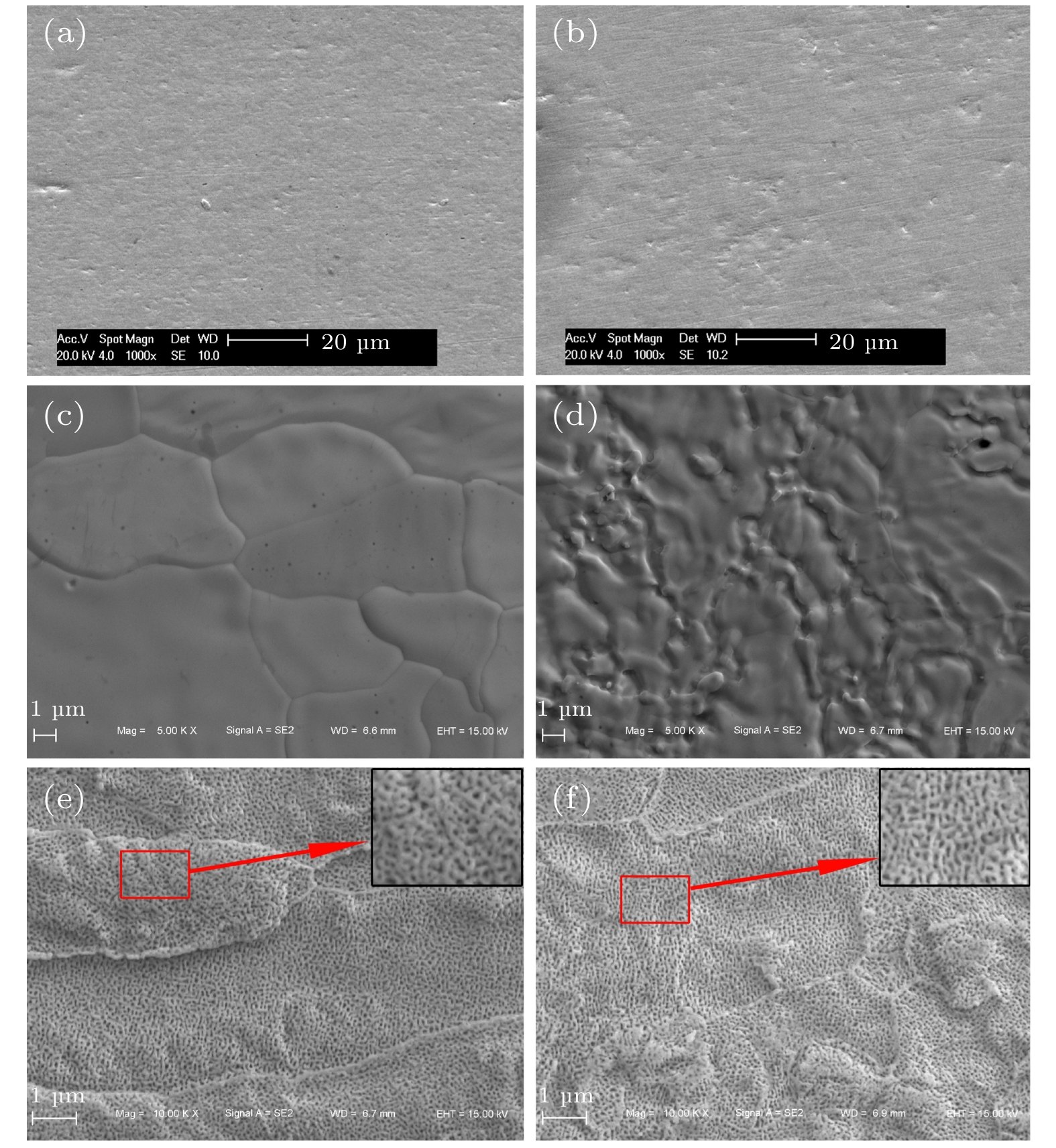
 下载:
下载:
